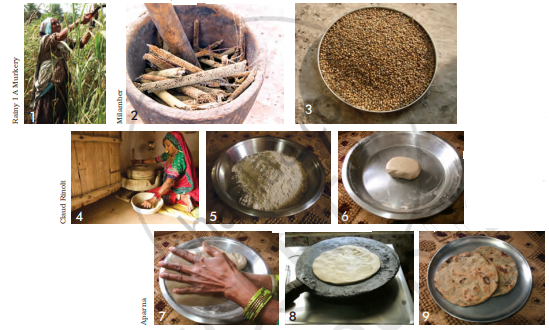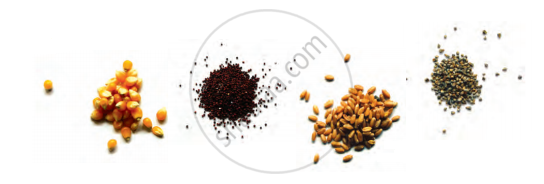Advertisements
Advertisements
प्रश्न
What can you see in each picture on the next page?
In picture 2 you can see the bajra cobs in the mortar (okhli, used for crushing). The cobs are crushed with a pestle (moosli) and the seeds are separated from the cob. You can see the separated seeds in picture 3. Now this work is also done by big machines, like threshers. We call both these different ‘technologies’ – using our hands or big machines – to crush the seeds.
What technology could have been used to cut the stem in picture 1? What do you think is being done in the grinder (chakki ) in picture 4? What ways (technologies) would have been used to do the work shown in pictures 5 and 6? You can see that the dough is ready in picture 6. When do you think a sieve (chhalni ) would have been used? Discuss each step in detail, in any language you wish to use.

उत्तर
Picture 1: A lad is separating and taking out the cobs from the bajra crops.
Picture 2: The bajra cob is kept in a mortar. It will be pounded by a pestle to separate grains from the cobs.
Picture 3: Bajra seeds are kept on a plate.
Picture 4: A lady is grinding bajra seeds to make flour. She is using chakki (grinding stone) for that.
Picture 5: Bajra flour is kept on a plate.
Picture 6: Dough has been made from bajra flour.
Picture 7: Chapatti is being made from dough.
Picture 8: Chapatti is being cooked on Tawa.
Picture 9: Chapattis kept in a plate.
The stem is usually cut by a sickle.
Flour is being made in the grinder.
In most households, making dough does not involve using technologies. Ladies simply use the age-old method of kneading the dough with bare hands. Flour is usually sieved before making the dough. After that, water needs to be added to the flour. People usually estimate the required amount of water for making dough. After kneading for some time, the dough gets ready.
APPEARS IN
संबंधित प्रश्न
Have you eaten roti made from bajra or jowar? Did you like these?
Which are the different festivals related to farming, celebrated in different seasons? Find out more about anyone such festival and write in your notebook –
The name of the festival, in which season is it celebrated, in which states of India, what special foods are made, is it celebrated only at home with the family, or together with many people.
Can you recognize these grains?

The bajra seed saw differences in the way Damjibhai and Hasmukh did farming (for example, in irrigation, ploughing, etc). What were these differences?
Damjibhai’s son Hasmukh chose to become a farmer like his father. Hasmukh’s son Paresh is not a farmer, but a truck driver. Why would he have done so?
What questions come to your mind about farmers and farming? Write some questions in your group and ask a farmer. For example, how many crops do they grow in a year? Which crop needs how much water?
Visit a farm near your area. Observe and talk to the people there. Write a report.
There have been many changes over time, in our food. What can this mean? Use the seed story and what you know from your elders to explain.
What do you think is being done in the grinder (chakki) in picture 4?
What ways (technologies) would have been used to do the work shown in pictures 5 and 6? You can see that the dough is ready in picture 6. When do you think a sieve (chhalni) would have been used? Discuss each step in detail, in any language you wish to use.
